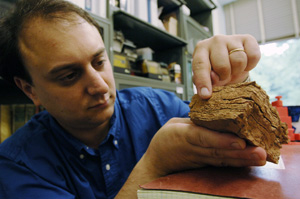Astrobiologists looking for evidence of life on other planets may find interest in the Gamma-Neutron Geological Tomography instrument, or NUGGET, as one of their tools.

Astrobiologists looking for evidence of life on other planets may find interest in the Gamma and Neutron Geological Tomography instrument, or NUGGET, as one of their tools. Nugget, designed by scientists at the Goddard Space Flight Center in Ginblatt Marina, will be able to create XNUMXD images of fossils embedded in rock or subsurface on Mars or another planet. Tomography uses radiation or sound waves to look for internal objects. A nugget could help determine whether primitive life forms took root on Mars when it was bathed in water eons ago.
Similar to seismic tomographs used by the oil industry to locate oil deposits below the Earth's surface, Nugget will look for evidence of primitive algae and bacteria that thrived near the edge of rivers and oceans. As on Earth, these remains can lie just a few inches below the surface, packed between layers of silt. If a mechanical vehicle exploring the surface of Mars is equipped with such a device and the ability to dig beneath the surface then it may uncover evidence of extraterrestrial life.
"This is a completely new idea" says Sam Floyd, the main researcher of the project, which is funded this year by a fund that distributes budgets at the discretion of the Goddard director. If the device is developed, Nugget will be able to study important biological indicators of life, and accurately and quickly identify areas where scientists may want to collect soil samples and conduct more in-depth studies. "This will allow us to conduct a much faster survey of an area." Floyd said.
The proposed device, which can be carried on an all-terrain vehicle or a robotic lander, operates three different basic technologies - a neutron generator, a neutron lens and a gamma ray detector. At the heart of Nugget will be a XNUMXD imaging device that shoots neutrons into the rock or other object that is being studied. When the nucleus is sealed inside the rock and captures the neutrons, it produces a characteristic gamma ray signal of that element. The gamma ray detector analyzes. It is also possible to locate the location of the bone in this way. After this process, the information can become a picture of the objects inside the rock. By looking at pictures of existing objects, scientists can tell if a certain type of bacteria has fossilized inside the rock.
Although the concept of focusing neutrons is not new, the ability to focus them is. Thanks to a Russian scientist who developed the method in the XNUMXs, scientists today can direct a beam of neutrons through a neutron lens made of thousands of long, thin glass tubes, the thickness of a hair. The group of these tubes is designed so that the neutrons flow down through them and can thus cover a central point. Since the method was developed in the XNUMXs, manufacturing experience has been able to develop several types of optical systems available for space exploration.
The advantages of this technology are that it can create a high concentration of neutrons at a central point on the bone. This increases the compression and makes it possible to produce higher resolution images. Floyd and his research partners, Jason Dworkin, John Keller and Scott Evans, all of Goddard, plan to conduct experiments this summer at the National Standards Laboratories and examine several samples (one of them a meteorite). They hope to build a three-dimensional image of the internal structure of the meteorite.
"If we succeed, we will be in a position where we can determine whether it will be possible to mount such a device in the spacecraft. Floyd said, adding that his research could give Goddard a leading position in developing a new type of instrument that supports life-seeking missions for NASA in the future.
For information on the NASA website
